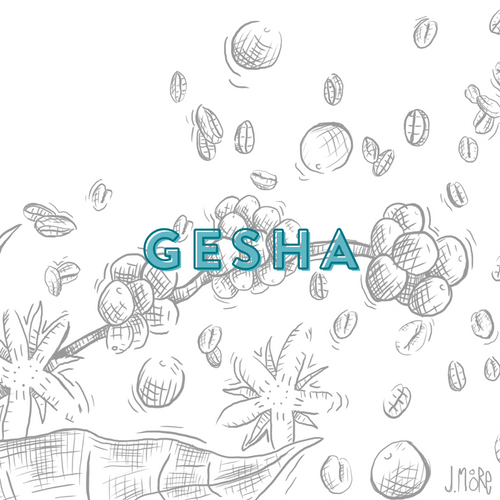The Alluring World of Gesha Coffee: Everything You Need to Know About this Rare and Exquisite Varietal

Table of Contents
- Introduction
- What is Gesha (Geisha) Coffee?
- History and Origin of Gesha Coffee
- Why is Gesha Coffee So Special?
- Gesha Flavor Profile: A Symphony of Aromas and Tastes
- Where is Gesha Coffee Grown?
- From Farm to Cup: Processing Methods for Gesha Coffee
- Brewing Gesha Coffee at Home
- How to Store and Preserve Gesha Coffee
- Why is Gesha Coffee So Expensive?
- Pairing Gesha Coffee with Food
- Where to Find Gesha Coffee
- Conclusion
1. Introduction
At Foster Coffee, we believe coffee is more than just a beverage—it's an experience that rich in history and complexity in every cup. Among the many coffee varietals in the world, Gesha (also spelled Geisha) stands out as one of the most sought-after and luxurious coffees you can experience. Known for its exquisite flavor profile, rarity, and captivating history, Gesha has taken the specialty coffee world by storm.
In this comprehensive guide, we’ll explore everything you need to know about this legendary coffee varietal, including its history, cultivation, flavor characteristics, and how you can make the most of it at home. Whether you're a seasoned coffee aficionado or simply curious about exploring new coffees, we invite you to journey with us through the enthralling world of Gesha coffee.
2. What is Gesha (Geisha) Coffee?
The Gesha (often spelled Geisha) coffee varietal is a rare type of Arabica coffee bean that originated in the village of Gesha in the southwestern region of Ethiopia. While Ethiopia is the birthplace of coffee itself, Gesha coffee gained its worldwide fame after being cultivated in Panama, where farmers discovered it could produce an incredibly complex flavor profile. The coffee was later introduced to specialty coffee competitions, quickly earning global recognition.
Today, Gesha coffee is prized for its:
- Unique and delicate floral bouquet
- Intricate layers of flavor, often described as jasmine, bergamot, and bright citrus
- High cupping scores in specialty coffee evaluations
Gesha is, at its core, a variety of the Arabica coffee species—one that demands careful cultivation, meticulous processing, and expert brewing techniques to fully unleash its potential.
3. History and Origin of Gesha Coffee
The story of Gesha coffee begins in the early 20th century. Coffee researchers and explorers were continually seeking new coffee varieties in Ethiopia—widely regarded as the birthplace of coffee. In the 1930s, British colonial agronomists collected seeds from the Gesha region (also spelled “Geisha”) in southwestern Ethiopia. These seeds were later planted and experimented with in research stations across Africa and Latin America.
The Journey to Panama
While most coffee enthusiasts associate the name "Geisha" with Panama, it actually took decades for the variety to find its way there. In the 1960s, Panamanian coffee growers were looking for disease-resistant coffee plants and imported several seed varieties from Costa Rica, which had received seeds from Ethiopian sources. One of those experimental varieties was the Gesha.
For years, however, the Gesha plants in Panama did not receive significant attention. They were planted in small lots or left interspersed among other coffee varietals without much fanfare. Everything changed in 2004, when the now-famous Hacienda La Esmeralda in Panama submitted a batch of their Gesha beans to the “Best of Panama” coffee competition. The judges were astounded by the coffee's exceedingly floral, tea-like aroma and lively brightness. Gesha quickly became the talk of the coffee world, setting auction price records and propelling Panama into the upper echelon of specialty coffee–producing nations.
Recognition and Global Acclaim
From that point forward, the reputation of Gesha soared. Specialty coffee enthusiasts, roasters, and connoisseurs worldwide began to seek out this rare and delightful coffee. It won multiple awards in competitions across the globe and started fetching astronomical prices at auction. Its popularity encouraged farmers in other regions—such as Colombia, Costa Rica, and Ethiopia itself—to cultivate the variety under carefully controlled conditions.
Through its remarkable history and global journey, Gesha coffee remains a testament to the dynamic and interconnected nature of the coffee community. The variety’s lineage highlights how a humble seed from Ethiopia’s forests can revolutionize coffee culture on another continent—and then return to its homeland to further develop coffee excellence.
4. Why is Gesha Coffee So Special?
Several factors set Gesha coffee apart from other coffee varietals:
- Unique Genetics: Gesha is genetically distinct within the Arabica species, which partly explains its exceptional flavor notes.
- Meticulous Cultivation: Farmers who grow Gesha dedicate special attention to soil quality, microclimates, and elevations. The variety thrives at higher altitudes, often above 1,600 meters, producing slower-maturing beans that develop more nuanced flavors.
- Small Yields: Gesha plants often yield fewer coffee cherries than other varieties, making them more expensive to cultivate. However, this smaller yield also contributes to higher bean density and concentrated flavor.
- Optimal Processing: Because Gesha coffee is so prized, farmers often invest in the best possible processing methods—washed, natural, or experimental techniques—leading to remarkable clarity and complexity in the cup.
- Intricate Flavor Profile: What truly cements Gesha’s reputation is its floral, tea-like, and citrus-laced tasting experience. Many coffee cuppers report flavors like jasmine, bergamot, peach, apricot, and tropical fruit.
These factors combine to create an aura of exclusivity and prestige around Gesha. While other coffee varietals can also produce excellent quality, Gesha’s hallmark is its consistent ability to reach soaring flavor heights when grown and processed with care.
5. Gesha Flavor Profile: A Symphony of Aromas and Tastes
Gesha coffee is often described with a flurry of tasting notes that rival those of artisanal teas, fine wines, or craft beers. Although each lot can have its own nuanced flavor characteristics, Gesha typically shines with:
- Floral Aromas: Jasmine and lavender are common descriptors. Some tasters also note roses or orange blossoms.
- Citrus Notes: Light notes of lemon, bergamot (like Earl Grey tea), or lime zest.
- Stone Fruit Sweetness: Peach, apricot, or nectarine undertones often come through, especially in naturally processed Gesha coffees.
- Tea-Like Qualities: A clean, refined mouthfeel that may resemble a high-quality black or green tea.
- Sweet, Lingering Finish: Delicate sweetness reminiscent of honey or cane sugar, leaving a remarkably pleasant aftertaste.
These nuanced notes make Gesha coffee particularly appealing to those who enjoy floral teas or complex beverages. Its flavor profile can be so lively and multifaceted that many coffee drinkers consider it a special occasion brew.
6. Where is Gesha Coffee Grown?
While Ethiopia is where the varietal originated, and Panama is where it achieved fame, Gesha coffee is now grown in many places around the world, including:
- Panama: Arguably the most famous origin for Gesha, particularly in areas like Boquete and Volcán.
- Ethiopia: The Gesha region continues to cultivate the variety, along with other coffee-growing areas. Ethiopian Gesha is often prized for its distinctive heirloom genetics.
- Costa Rica: Notably in Tarrazú and West Valley regions, where high-altitude farms produce exceptional lots of Gesha.
- Colombia: Farms in Huila, Nariño, and other highland regions have begun experimenting with Gesha, achieving impressive results.
- Guatemala: Some farms have recently started producing small quantities of Gesha, focusing on specialty-grade coffees for niche markets.
Despite its growing popularity, Gesha remains relatively rare. This scarcity is due in part to its delicate cultivation requirements and the fact that not all farms have the right microclimate to bring out the varietal’s best qualities.
7. From Farm to Cup: Processing Methods for Gesha Coffee
Just as the terroir and climate affect Gesha’s profile, so does the processing method. Generally, three main processing techniques are used, each yielding unique flavor and aroma nuances:
-
Washed Process
- Method: The coffee cherries are pulped, removing most of the fruit before the beans are fermented in water to remove the remaining mucilage. After fermentation, the beans are washed and dried.
- Flavor Profile: Washed Gesha coffees are often celebrated for their crisp clarity, bright acidity, and pure floral notes (such as jasmine). You can more easily detect individual flavor nuances, like citrus or peach.
-
Natural (Dry) Process
- Method: The coffee cherries are left to dry intact with their skins and pulp still attached. Over the course of drying, the fruit’s sugars infuse deeper into the bean.
- Flavor Profile: Natural Gesha tends to be fruit-forward, with pronounced sweetness and sometimes vibrant tropical or berry-like flavors. It can also develop a heavier body and a winey complexity.
-
Honey (Pulped Natural) Process
- Method: The outer skin is removed, but some or all of the sticky pulp (mucilage) remains on the bean during drying.
- Flavor Profile: Honey-processed Gesha often strikes a balance between the clarity of a washed process and the fruity sweetness of a natural. Expect a rounder mouthfeel with bright florals and subtle fruit notes.
Some farms experiment with anaerobic fermentation, carbonic maceration, and other innovative processing methods. Regardless of the approach, the goal is to accentuate the inherent, delicate qualities that make Gesha coffee so remarkable.
8. Brewing Gesha Coffee at Home
One of the joys of experiencing Gesha coffee is the chance to brew it yourself. Because Gesha beans are typically more expensive, you’ll want to use methods that preserve and highlight their complexity. Here are some recommendations:
1. Pour-Over (e.g., Hario V60, Kalita Wave, Chemex)
- Why It Works: A pour-over method provides a gentle extraction, allowing the complexity and floral notes to shine.
- Tips: Use a relatively coarse grind (slightly finer than for drip coffee), freshly roasted beans, and filtered water. Aim for a water temperature of 195–205°F (90–96°C). Experiment with bloom time (usually 30–45 seconds) to help release trapped CO2 from fresh beans.
2. Manual Drip Brewer (e.g., Clever Dripper, AeroPress)
- Why It Works: Immersion methods like the Clever Dripper and the AeroPress give you more control over steep time, producing a consistent and balanced cup.
- Tips: For the AeroPress, try the inverted method for added control. A brew time of around 2–3 minutes is often ideal. Adjust your grind and brew time to bring out the coffee's floral and citrus notes.
3. Automatic Drip Machine
- Why It Works: Modern drip machines can produce decent results if they maintain the correct water temperature.
- Tips: While not the most recommended method for showcasing a top-tier coffee like Gesha, a high-quality drip machine with precise temperature control and a showerhead design can yield a pleasing cup. Just ensure you use fresh, properly ground beans.
4. Avoid Espresso—at First
- Why? Espresso can mask some of Gesha's more delicate notes. The high pressure and short extraction time can overshadow the subtle complexity. If you do try espresso, keep in mind that you might need to adjust your brew ratio and extraction time carefully to avoid overwhelming bitterness or sourness.
9. How to Store and Preserve Gesha Coffee
Given the premium nature of Gesha coffee, proper storage is crucial to preserve those sublime flavors. Follow these tips:
- Keep It Airtight: Store beans in a container with a one-way valve or in the original resealable bag with minimal exposure to oxygen.
- Avoid Light and Heat: Light and high temperatures rapidly degrade coffee quality. Keep your Gesha beans in a cool, dark place—like a cupboard away from direct sunlight or heat sources.
- Buy Small Quantities: Because of its rarity and expense, it’s best to buy small batches of Gesha to ensure maximum freshness.
- Grind Just Before Brewing: Pre-grinding speeds up the oxidation process. If you want the best experience, grind the beans as close to brewing time as possible.
10. Why is Gesha Coffee So Expensive?
If you’ve searched for Gesha coffee online or in specialty shops, you’ve likely experienced sticker shock. Gesha is often sold at prices far above typical specialty coffees. Here’s why:
-
Rarity
- Low Yield: Gesha plants typically produce fewer cherries than other coffee varieties.
- Limited Acreage: Not all farms can successfully grow Gesha due to its preference for specific climates and higher altitudes.
-
High Demand
- Coffee aficionados, competition judges, and specialty roasters around the globe covet Gesha for its unique flavor profile.
- Limited supply + high demand = higher market prices.
-
Labor-Intensive Cultivation
- Gesha plants are delicate and require careful attention and management. Farmers must invest in training, top-quality fertilizers, and precise agricultural techniques to ensure a superior end product.
-
Exceptional Quality
- Gesha has topped multiple coffee competitions and set auction price records. Consumers and roasters alike are willing to pay a premium for these world-class coffees.
While the price can be daunting, many coffee lovers find Gesha worth the splurge—especially when they savor the memorable taste in each sip.
11. Pairing Gesha Coffee with Food
Though Gesha coffee is often enjoyed on its own to appreciate the delicate complexities, certain food pairings can complement or enhance its distinctive flavor profile.
-
Light Pastries and Scones
- Delicate pastries like plain croissants, madeleines, or shortbread cookies can let the coffee’s floral and fruity notes stand out without overpowering them.
-
Fruit-Based Desserts
- Fresh fruit tarts, lemon bars, or peach-based desserts offer a subtle sweetness that can mirror the bright, fruity undertones in Gesha coffee.
-
Soft Cheeses
- Mild cheeses such as brie or camembert can complement Gesha’s floral brightness, adding a creamy counterpoint to the coffee’s acidity.
-
Dark Chocolate
- If you prefer bolder pairings, a piece of high-quality dark chocolate (70% or above) can highlight the coffee’s sweet, lingering finish and bring out deeper nuances.
12. Where to Find Gesha Coffee
If you’re ready to explore the wonders of Gesha coffee, you can look for it in several places:
- Specialty Coffee Roasters: Many niche roasters feature small, limited releases of Gesha. Always check the roast date to ensure freshness.
- Online Specialty Coffee Retailers: Various e-commerce platforms specializing in high-end coffee occasionally stock Gesha lots from acclaimed farms.
- Directly from Farms: Some farms, especially in Panama or Ethiopia, allow international orders. You might be able to purchase small batches from their websites or through auctions.
- Foster Coffee: We at Foster Coffee love exploring rare and unique coffees. Keep an eye on our offerings or sign up for our newsletter to discover if a Gesha release is in the works!
13. Conclusion
Gesha coffee (also spelled Geisha) stands in a class of its own—an illustrious varietal that has captivated the specialty coffee world for decades. From its origins in the forests of Ethiopia’s Gesha region to its rise to global fame in the highlands of Panama, this coffee has traveled far and wide, enchanting coffee enthusiasts every step of the way.
What sets Gesha apart? Its delicate floral aroma, bright acidity, vibrant fruit notes, and tea-like body are just some of the qualities that make it a truly gourmet experience. Coupled with its rarity and meticulous cultivation, Gesha frequently commands top dollar at auctions and roasteries alike. However, for those who truly appreciate the finer nuances of coffee, the price can be justified by the unforgettable tasting journey it provides.
Key Takeaways
- Unique Origin: Gesha’s roots trace back to Ethiopia, but it found fame in Panama.
- Flavor Complexity: Expect floral (jasmine, lavender), citrus (bergamot, lemon), and stone fruit (peach, apricot) notes in many Gesha cups.
- Selective Cultivation: Grown at high altitudes and often meticulously processed, Gesha is labor-intensive and yields fewer cherries than other varieties.
- Brewing Tips: Emphasize clarity and subtlety with methods like pour-over or immersion. Store beans properly to maintain freshness.
- Rare and Premium: Gesha’s scarcity and superior quality make it among the most expensive coffee varietals in the world.
- Where to Find: Specialty roasters, online coffee marketplaces, and farms selling directly. Keep an eye out on Foster Coffee for special releases or limited-edition features.
Whether you’re indulging in your first cup of Gesha or revisiting this coffee legend, it’s essential to brew it carefully and savor each sip. When approached with mindfulness, Gesha coffee can take your palate on an unforgettable journey that honors its rich, global history. The experience is more than a morning jolt; it’s a celebration of coffee’s ability to unite cultures, push boundaries, and create meaningful moments in every cup.
At Foster Coffee, we’re passionate about exploring all facets of coffee—from everyday brews to premium, rare varietals like Gesha. We hope this guide not only satisfies your curiosity but also inspires you to delve deeper into the exquisite world of Gesha coffee. Feel free to share your experiences, pairing ideas, and brewing tips with us. Let’s continue the conversation and celebrate the boundless wonder of coffee together!
Additional Resources
- Specialty Coffee Association (SCA) – Offers insight into cupping standards and the science of coffee flavors.
- Cup of Excellence – Showcases award-winning coffees from around the globe, including occasional Gesha lots.
- World Coffee Research – For those curious about the genetic diversity and breeding of coffee varietals.
Disclaimer
The information provided here about Gesha coffee is intended to serve as an educational resource. Tasting notes, flavor descriptions, and brewing methods can vary based on individual preferences, local conditions, and the unique characteristics of each coffee lot. Always experiment and explore what works best for you. If you have any questions or feedback, feel free to reach out to us at Foster Coffee or consult with a certified coffee professional. Enjoy your cup!
Thank you for reading our comprehensive guide on Gesha coffee! If you found this blog post helpful, please consider sharing it with fellow coffee lovers. Don’t forget to explore Foster Coffee for more deep dives into specialty coffee, brewing techniques, and all things coffee culture.
- Tags: Education




